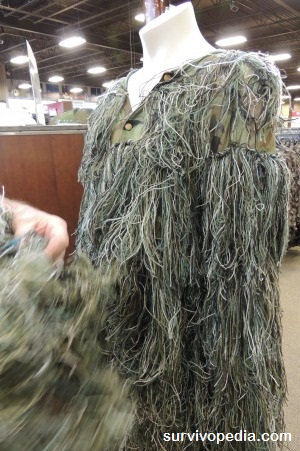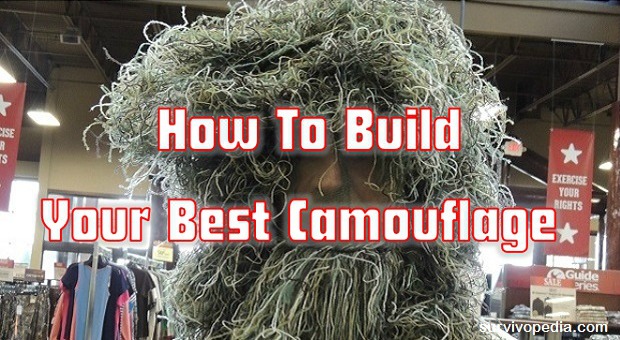When talking about camouflage, there are basically two types of gear: camouflage clothes and ghillie suits.
Camouflage gear is is a must have piece of gear if you’re a sniper, a soldier or a hunter. Ghillie suits were originally designed for hunting purposes, but later on they were used by military forces, because they’re great at making people invisible or very close to it.
Basically, regardless of your intents and purposes, if you want to blend into your surroundings, camouflage gear is essential.
The key elements for efficient camouflage are inspired from the animal reign (think polar bears or chameleons), i.e. the color scheme is essential, together with efficient 3D dimensional textures, which is aimed at diffusing and blending your figure/silhouette into the surroundings, thus fooling the eye.
If these two work together as a whole, the color scheme and the 3D (three dimensional) textures, you’re hitting the sweet spot in terms of good camouflage, being basically unrecognizable and virtually invisible from the distance.
It’s just like in the cool meme, with the apprentice sniper being admonished by the sergeant, something like “Smith, I haven’t seen you at camouflage practice” and Smith going like: “Thank you Sir”.
Let’s take a closer look about camouflage basics and start from there.
So, commercial or home-made regular 2D (bi-dimensional) camouflage is pretty good at helping you blending into all sorts of backgrounds, but it can’t mitigate one of the most tell-tell signs of you presence, i.e. your silhouette.
Hard core hunters and veteran hiders, such as military snipers or undercover spooks always rely on 3D camouflage, which consists of entire suits that are built using billowy materials, which help with blurring their outline, thus allowing them to become virtually invisible or to disappear in plain sight.
So, there’s regular 2D camouflage and the ultimate 3D camouflage, namely the ghillies.
Ghillie suits were first invented by Scottish folk, game keepers who probably were pretty good at tax evasion too using those suits (just kidding).
To begin with, let’s quote Sun Tzu, the Chinese general who wrote The Art of War thousands of years ago:
“Be extremely subtle, even to the point of formlessness. Be extremely mysterious, even to the point of soundlessness. Thereby you can be the director of the opponent’s fate.”
Find out more on how to improve your defense techniques to survive disaster!
Camouflage Clothes – the Basic Gear for Ghosts
The first step is to determine your required 3 base-colors i.e. the top three most prevalent colors which are to be found in the environment you want to blend in. Don’t worry about exact tones and hues, just choose general colors.
For example, go for dark green/dark brown/black clothes and don’t waste your time trying to find pine needle green or chestnut brown.
If you’ve already determined the color scheme required for your camouflage purposes, buy plain colored T shirts/long sleeve/whatever you need in the respective color and stay away from fancy/expensive brands, the name of the game is utility and economy, otherwise you can buy commercially available camo, right?
The same concept goes for the hat and pants. Here’s a video tutorial with a guy who made his own camo shirt and pants using just a few common items besides the clothes themselves, namely a spray paint, some spare newspapers and some foliage with leaves.
Video first seen on Random Things.
The trick is to spray paint the leaves pattern onto the clothes and that’s about it, you’ll end up with home made camo for dirt cheap prices, especially if you’ll be using old clothes. The end result is pretty convincing.
The Ghillie Suit

Ghillie suits are arguably the best type of camouflage one can wear, as it helps you to integrate seamlessly (if it’s proper made obviously) into your surroundings, as it uses branches, foliage and/or leaves to break up your silhouette.
You’ll start with your already-made camo clothes, i.e. normal clothing spray painted (you can also use fabric patches) to match your desired surroundings.
A ghillie suit is basically 3D camo and it’s usually built using burlap, netting, sewing needles, dental floss and glue. Nothing fancy, nothing expensive.
The thing is, there are two basic designs for ghillie suits: the simple net for fixed positions and the suit construction.
The simple net design has advantages and disadvantages. For example, it’s pretty hard to use while on the move through forests/brush and it’s also very difficult to crawl in. The bright side is that simple net ghillies are light weight, hugely adaptable to fixed positions and they roll up forming a small bundle.
You can use camouflage netting which can be bought at army surplus stores, else you can always choose shrimp net or fish net (the former is the best as it’s treated with anti rot coating).
Suit construction requires a decoy bag, raffia grass, burlap, fabric dye, rubber bands, jute twine and seam reaper. Here’s a video on how to build a ghillie suit from the ground up using readily available and dirt cheap materials.
Video first seen on Zachary Crossman.
The most important customizing option for your ghillie suit it the use of natural vegetation, but this trick comes with the disadvantage that natural vegetation will wither and brown in a couple of hours. Here raffia grass comes into play, as it’s perfectly suited for dyeing and it’s extremely effective in desert, grassland and winter environments.
Other options include using spanish moss, carpet moss or even artificial vegetation and there’s a wide selection of artificial vegetation at hobby stores. You can mitigate its glossy appearance which is common with plastic made plants by using a flat spray paint in your desired color. Plastic vegetation can be painted/repainted ad nauseam,
Don’t worry, building your own ghillie suit doesn’t require mad skills, you’ll just have to know how to tie simple knots, to recognize plant shapes and mix different colors together.
What’s important before proceeding with your DIY job is proper fieldwork research, namely taking notes and photos that will help you with color matching your ghillie suit. Yes, you’ll have to do some scouting, going out to the grasslands/woods/desert plateau or wherever you plan to use your camo and observe the coloration of the terrain with your own eyes.
Building your own ghillie suit offers you some advantages and tactical options vs the commercially available ones (which are also pretty expensive).
For example, you can add a recoil pad pocket if you’re using your suit for hunting purposes, or a hydration pack for wearing it in warm climates, not to mention waterproofing on the areas that come in contact with moisture, thus helping you stay dry in wet environments.
Another advantage of a home made ghillie suit is that it will match accurately the color of your desired environment you wish to blend into, as opposed to commercial ones which are usually available for just 2 environments.
That about sums it up for today. I hope you enjoyed reading the article. If you have questions or comments, don’t hesitate to use the dedicated section below. Good luck, and stay prepared folks!
This article has been written by Chris Black for Survivopedia.
6 total views, 1 views today
from Survivopedia
Don't forget to visit the store and pick up some gear at The COR Outfitters. How prepared are you for emergencies?
#SurvivalFirestarter #SurvivalBugOutBackpack #PrepperSurvivalPack #SHTFGear #SHTFBag



No comments:
Post a Comment